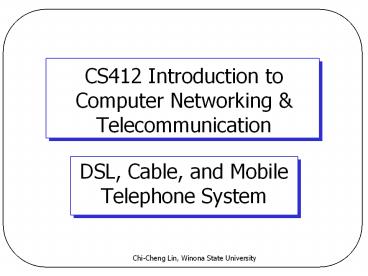CS412 Introduction to Computer Networking - PowerPoint PPT Presentation
Title:
CS412 Introduction to Computer Networking
Description:
CS412 Introduction to Computer Networking & Telecommunication DSL, Cable, and Mobile Telephone System Topics Digital Subscriber Line Cable Mobile Telephone System ... – PowerPoint PPT presentation
Number of Views:148
Avg rating:3.0/5.0
Title: CS412 Introduction to Computer Networking
1
CS412 Introduction to Computer Networking
Telecommunication
- DSL, Cable, and Mobile Telephone System
2
Topics
- Digital Subscriber Line
- Cable
- Mobile Telephone System
3
Digital Subscriber Lines
- Bandwidth versus distanced over category 3 UTP
for DSL.
4
Digital Subscriber Lines
- Operation of ADSL using discrete multitone
modulation.
5
Figure 9.1 DMT
6
Figure 9.2 Bandwidth division
7
Digital Subscriber Lines
- A typical ADSL equipment configuration.
8
Figure 9.3 ADSL modem
9
Figure 9.4 DSLAM
10
Wireless Local Loops
- Architecture of an LMDS system.
11
Cable Television
- Community Antenna Television
- Internet over Cable
- Spectrum Allocation
- Cable Modems
- ADSL versus Cable
12
Community Antenna Television
- An early cable television system.
13
Internet over Cable
- Cable television
14
Compared to Telephone System
- The fixed telephone system.
15
Spectrum Allocation
- Frequency allocation in a typical cable TV system
used for Internet access
16
Cable Modems
- Typical details of the upstream and downstream
channels in North America.
17
Figure 9.8 Cable modem
18
Figure 9.9 CMTS
19
ADSL versus Cable
- Discussions
20
Mobile Telephone System
- First-Generation Mobile Phones
- Analog Voice
- Second-Generation Mobile Phones
- Digital Voice
- Third-Generation Mobile Phones
- Digital Voice and Data
21
Advanced Mobile Phone System
- Area is divided into cells with an antenna
control by a cell office in each cell - Cell offices communicate with MTSO
- Transmission frequencies cannot be the same in
adjacent cells - Cell size is not fixed
- Smaller cells used in higher populated area
22
Figure 7-36
Cellular System
? The McGraw-Hill Companies, Inc., 1998
WCB/McGraw-Hill
23
Advanced Mobile Phone System
- (a) Frequencies are not reused in adjacent cells.
- (b) To add more users, smaller cells can be used.
24
Figure 17.2 Frequency reuse patterns
25
Cellular Transmission
- Traditionally analog
- FM used to minimized noise
- Digital transmission
- CDPD (Cellular Digital Packet Data)
- Low-speed digital service over existing cellular
network - Based on OSI Model
- Modem needed
26
Cellular System
- Handoff
- When a mobile telephone leaves a cell
- 1. Its base station notices the signal fading out
- 2. The base station asks all the surrounding base
stations how much power they are getting from it - 3. Ownership is transferred to the neighbor base
station that receives strongest power - 4. The telephone is informed of its new boss
- 5. If a call is in progress, it will be asked to
switch to a new channel
27
Channels
- 832 full-duplex channels
- Each channel consists of 2 simplex channels
- Transmission channels
- (849-824)MHz/30KHz ? 832
- Receiving channels
- (894-869)MHz/30KHz ? 832
- Typically, actual number of voice channel per
cell ? 45
28
Channel Categories
- The 832 channels are divided into four categories
- Control (base to mobile) to manage the system
- Paging (base to mobile) to alert users to calls
for them - Access (bidirectional) for call setup and channel
assignment - Data (bidirectional) for voice, fax, or data
29
Second-Generation Mobile Phones
- D-AMP
- GSM
- CDMA
30
D-AMPS Digital Advanced Mobile Phone System
- (a) A D-AMPS channel with three users.
- (b) A D-AMPS channel with six users.
31
GSMGlobal System for Mobile Communications
- GSM uses 124 frequency channels, each of which
uses an eight-slot TDM system
32
GSM
- A portion of the GSM framing structure.
33
Third-Generation Mobile PhonesDigital Voice and
Data
- Basic services an IMT-2000 network should provide
- High-quality voice transmission
- Messaging
- Replace e-mail, fax, SMS, chat, etc.
- Multimedia
- Music, videos, films, TV, etc.
- Internet access
- Web surfing, w/multimedia
- 2.5G, 4G,































